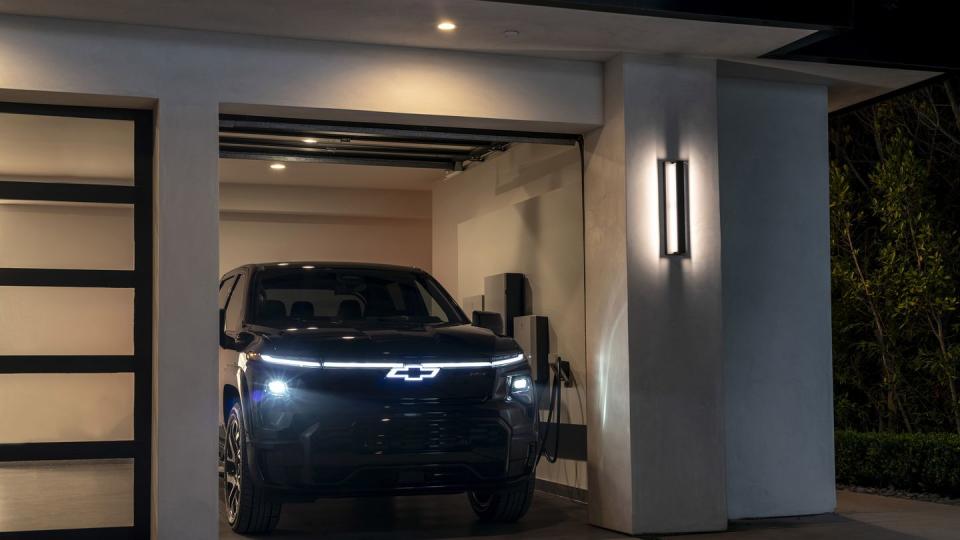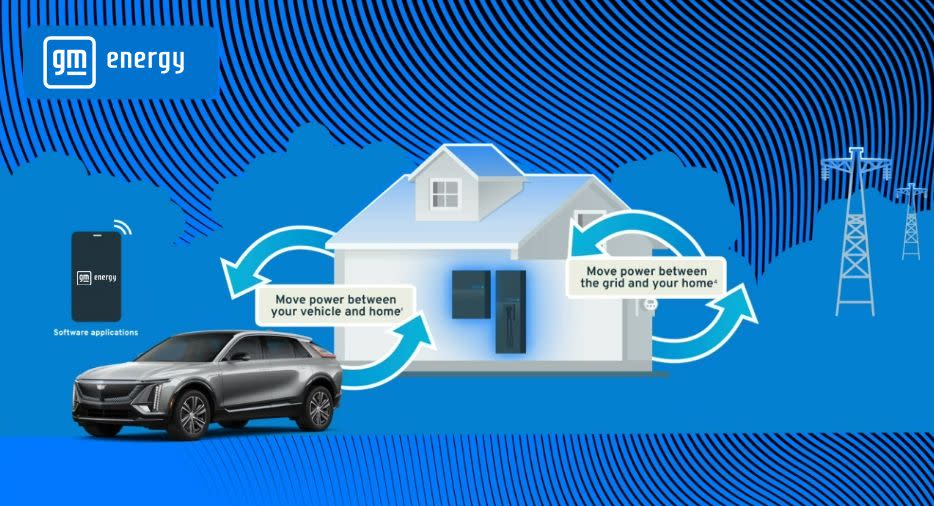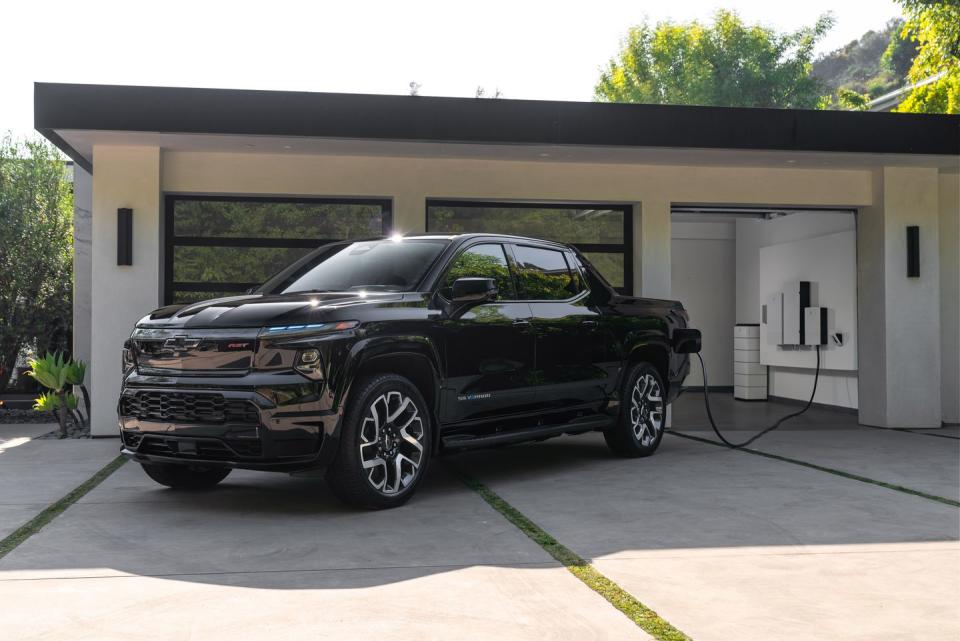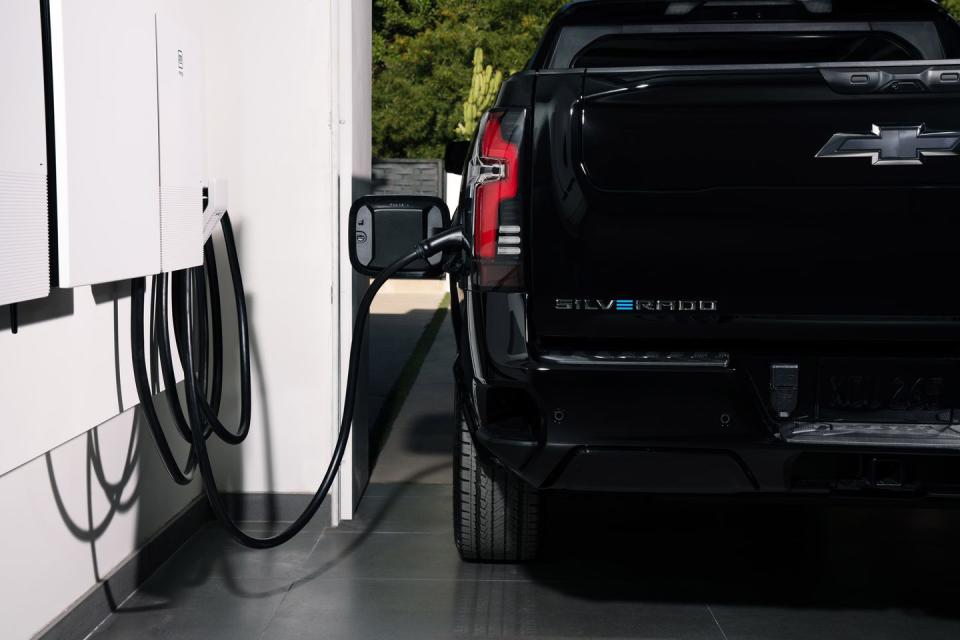GM Energy Powered a Mansion with an Electric Silverado Using V2H

GM Energy demonstrated its EV-as-home-power-supply tech by cutting the electricity at a Beverly Hills mansion outfitted with its new bidirectional charging equipment.
The lights went out momentarily while the home switched from grid power to juice supplied by a 2024 Chevrolet Silverado EV RST First Edition in the garage.
The system is available now and will be joined by a GM Energy battery backup module later this year.
With the exception of some reclusive cabin dwellers, it's not often that a homeowner happily cuts their domicile off from the electrical grid. And while that's not likely to be a regular occurrence, GM Energy did just that to show how one of its EVs can power a home in the event of an outage, real or otherwise.
The General Motors subsidiary is now marketing a V2H (vehicle-to-home) bidirectional charging system. Similar to the one Ford offers for the F-150 Lightning electric pickup, GM Energy’s solution can automatically switch a house from grid power to EV-supplied juice—provided the EV is at home and plugged in, of course. The system works with the RST model of the Chevy Silverado EV now, and support is forthcoming for 2024 models of Chevrolet's Equinox and Blazer EVs, the GMC Sierra EV Denali, and the Cadillac Lyriq.
We noticed that the first UItium-based EVs, the GMC Hummer SUV and Hummer pickup, are absent from this list. The chief engineer for the GM Energy system tells us these models could gain support at a later date through a software update, but none is promised as of yet.
The system starts with the GM Energy PowerShift Charger. GM EV owners can buy this as a stand-alone unit for normal Level 2 home-to-vehicle charging; enabling V2H requires the aptly named V2H Enablement Kit, which consists of a power inverter, a home hub, and a dark start battery.
(More fun with branding: If you're wondering what happened to the Ultium label these charging stations were supposed to wear, we were too. GM reps tell us the Ultium name is being reserved for the EV architecture technology, while GM Energy will be the name on its home and commercial power products.)
Where Can Equipment Go? Just about Anywhere
Why aren't those items packaged as one unit? We're told this is to allow for flexibility in locating each component. Because every home's layout and wiring is different, this allows the owner and installer to situate the system's parts where they make the most sense. They're all weatherproof and can be located indoors or out, and in many cases can be hidden in a utility room or somewhere they won't normally be seen.
How It Works
In normal circumstances when grid power is flowing, the dark start battery is trickle charging to keep itself topped up. Once the power goes out, it kicks into action, providing low-voltage power to the rest of the system, allowing them to communicate with one another and tell the EV to start shifting its power to the home.
The PowerShift charging unit essentially runs in reverse, supplying power to the inverter, which then feeds the home hub with AC that it distributes to the home's circuits. When the system is installed—GM has partnered with Qmerit to handle that job—you can decide whether the whole house gets backup power or only certain circuits. The equipment can supply up to 9.6 kW of power, which is plenty to keep the essentials running in most homes—even a 10,000-square-foot Beverly Hills mansion, apparently.

The changeover takes a matter of seconds from the lights going out to them coming back on again. In between, LEDs on the various components come alive thanks to the dark state battery, the clicking of relays can be heard as the hub locks out the connection to the grid and routes the supply from the EV to the home's circuits, and then you're back in business. The only hint that the home is on EV power is the near-imperceptible sound of the various components, which GM says emit less than 50 dB of noise, equivalent to the volume of a whisper.
How long the backup power lasts is a function of the vehicle's battery capacity—in this case, 200.0 kWh from a 2024 Silverado EV RST First Edition—that battery's state of charge, and what you decide to leave on during the outage. And lest you worry about damaging the EV battery through discharging, note that the power demand of a home is peanuts compared to that of a 754-hp electric powertrain. The average U.S. home consumes about 30 kWh of energy per day, meaning that $100,000 truck could keep you bathed in the artificial glow of your TV in cooled comfort for nearly a week. The RST defaults to shutting down power when its battery reaches 20 percent, but you can increase that buffer or take it all the way down to zero.
What If You Go Too Far?
And what happens if you overdo it? The system will shut off, first for 10 seconds, and then restart, which should give you time to turn off the crypto-mining rig that sent you over your power budget. If you don't get the hint, the power will then shut off for 20 seconds, with the interval increasing up to an unspecified limit or until you wise up. This is supposed to help you learn, and we think users are likely to get the picture after one or two such interruptions.
GM's existing brand-specific smartphone apps let you monitor everything, including the vehicle's state of charge, how much power the home is puling from the pack, and approximately how much longer the battery will last given current usage. Note that this requires your home's internet connection to be up and your wired or wireless network to have power, allowing it to send that data to the cloud, so make sure the necessary routers and modems are on a circuit that gets energized when backup kicks in. But the system will work regardless of whether data is flowing.
To make sure all of this will work in the real world, GM first tested everything on a simulated house load at its proving grounds. Once the system got the UL seal of approval, 10 engineers tested it out at their own homes, representing a variety of configurations. Hopefully this will help avoid some of the teething issues seen with Ford's system.

Ford vs. GM: Comparing the Prices
The PowerShift Charger alone runs $1699, while the V2H Enablement Kit costs $5600; GM Energy sells it all as a bundle for $7299, a savings of precisely $0. For comparison, Ford's equipment is $5205 all in. While both are far from cheap, they're comparable to the cost of a home generator. Installation is extra and varies in price based in part on the configuration and complexity of the job.
That Ford-to-GM pricing comparison is only relevant if you don't yet have a bidirectional-capable EV because for now, you can't plug a Ford into a GM-equipped house or vice versa. GM Energy tells us it will implement an ISO standard for interoperability once one exists. So at least for the near future, your electric garden will be walled.

And although it wasn't part of the demonstration, GM Energy did have its forthcoming PowerBank backup battery installed at the super-fancy demo house. This is something Ford doesn't offer, which might sway some customers from a Lightning to a Denali EV. Estimated pricing for a bundle that incudes the PowerShift charger, V2h Enablement Kit, and a 10.6-kWh storage battery is $12,699. GM Energy will also sell versions with 17.7- and 35.4-kWh capacities.
In addition to the home batteries, GM Energy plans to add solar integration later this year (something Ford offers through SunRun). GM is also working with utility companies nationwide to allow these batteries to give back to the grid in times of high demand, allowing them to act as a distributed buffer. But if you want to disconnect from the grid and live off your EV's power for a while, we'll understand.
You Might Also Like

 Yahoo Autos
Yahoo Autos 